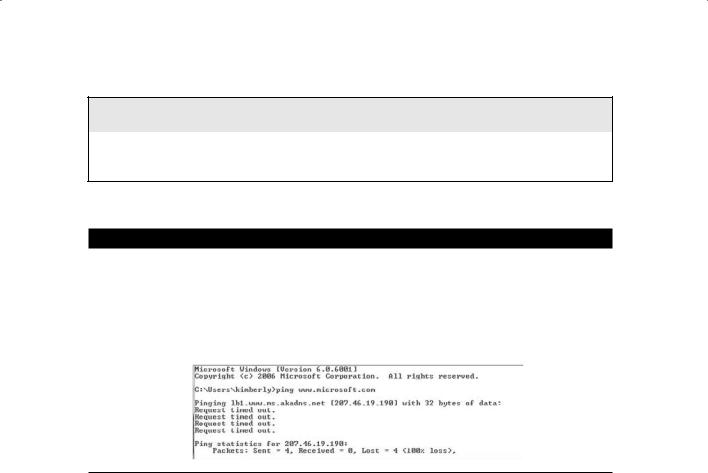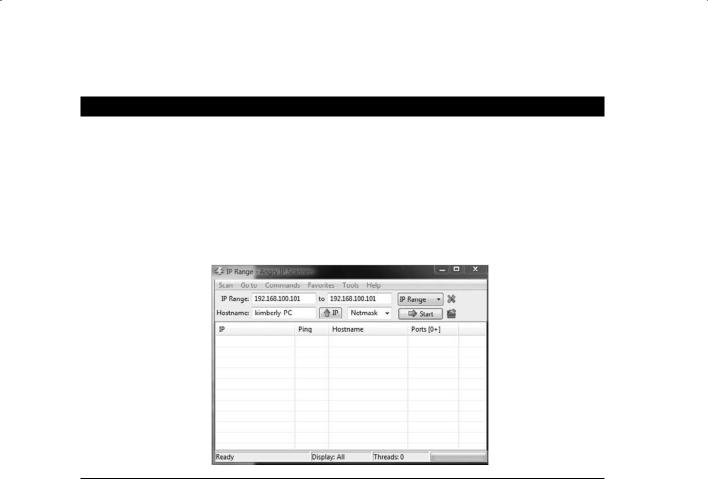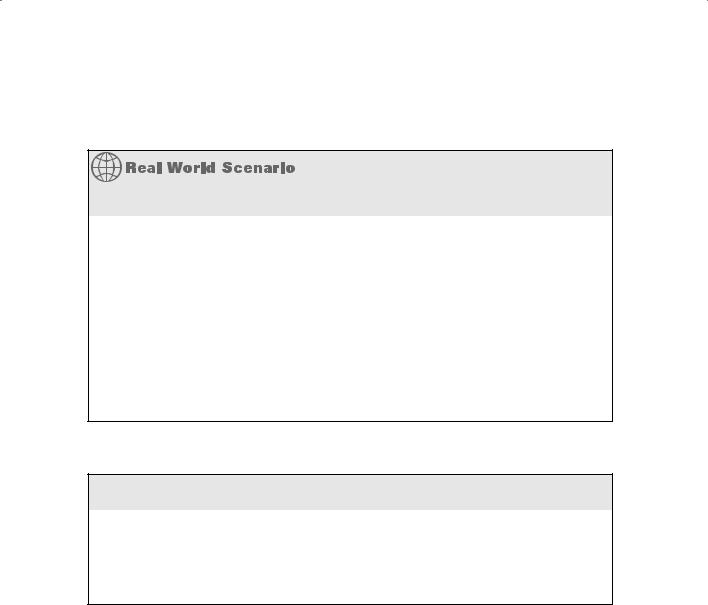
- •Acknowledgments
- •About the Author
- •Contents at a Glance
- •Contents
- •Table of Exercises
- •Introduction
- •Assessment Test
- •Answers to Assessment Test
- •Defining Ethical Hacking
- •How to Be Ethical
- •Keeping It Legal
- •Summary
- •Exam Essentials
- •Review Questions
- •Answers to Review Questions
- •Reconnaissance
- •Information-Gathering Methodology
- •Social Engineering
- •Summary
- •Exam Essentials
- •Review Questions
- •Answers to Review Questions
- •Scanning
- •Enumeration
- •Summary
- •Exam Essentials
- •Review Questions
- •Answers to Review Questions
- •The Simplest Way to Get a Password
- •Types of Passwords
- •Cracking a Password
- •Understanding Keyloggers and Other Spyware Technologies
- •Escalating Privileges
- •Understanding Rootkits
- •Hiding Files
- •Understanding Steganography Technologies
- •Summary
- •Exam Essentials
- •Review Questions
- •Answers to Review Questions
- •Trojans and Backdoors
- •Viruses and Worms
- •Summary
- •Exam Essentials
- •Review Questions
- •Answers to Review Questions
- •How a Sniffer Works
- •Sniffing Countermeasures
- •Bypassing the Limitations of Switches
- •Wireshark Filters
- •Summary
- •Exam Essentials
- •Review Questions
- •Answers to Review Questions
- •Denial of Service
- •Session Hijacking
- •Summary
- •Exam Essentials
- •Review Questions
- •Answers to Review Questions
- •How Web Servers Work
- •Types of Web Server Vulnerabilities
- •Web Application Vulnerabilities
- •Summary
- •Exam Essentials
- •Review Questions
- •Answers to Review Questions
- •SQL Injection
- •Buffer Overflows
- •Summary
- •Exam Essentials
- •Review Questions
- •Answers to Review Questions
- •Wi-Fi and Ethernet
- •Authentication and Cracking Techniques
- •Using Wireless Sniffers to Locate SSIDs
- •MAC Filters and MAC Spoofing
- •Rogue Access Points
- •Wireless Hacking Techniques
- •Securing Wireless Networks
- •Summary
- •Exam Essentials
- •Review Questions
- •Answers to Review Questions
- •Components of Physical Security
- •Understanding Physical Security
- •Physical Site Security Countermeasures
- •What to Do After a Security Breach Occurs
- •Summary
- •Exam Essentials
- •Review Questions
- •Answers to Review Questions
- •Linux Basics
- •Compiling a Linux Kernel
- •GCC Compilation Commands
- •Installing Linux Kernel Modules
- •Linux Hardening Methods
- •Summary
- •Exam Essentials
- •Review Questions
- •Answers to Review Questions
- •Types of IDSs and Evasion Techniques
- •Summary
- •Exam Essentials
- •Review Questions
- •Answers to Review Questions
- •Generating Public and Private Keys
- •Cryptography Algorithms
- •Summary
- •Exam Essentials
- •Review Questions
- •Answers to Review Questions
- •Defining Security Assessments
- •Penetration Testing
- •Pen Test Deliverables
- •Summary
- •Exam Essentials
- •Review Questions
- •Answers to Review Questions
- •Glossary
- •Index

Scanning is the first phase of active hacking and is used to locate target systems or networks for later attack. Enumeration is the follow-on step once scanning is complete and is used to
identify computer names, usernames, and shares. Scanning and enumeration are discussed together in this chapter because many hacking tools perform both steps simultaneously.
Scanning
After the reconnaissance and information-gathering stages have been completed, scanning is performed. It is important that the information-gathering stage be as complete as possible to identify the best location and targets to scan. During scanning, the hacker continues to gather information regarding the network and its individual host systems. Information such as IP addresses, operating system, services, and installed applications can help the hacker determine which type of exploit to use in hacking a system.
Scanning is the process of locating systems that are alive and responding on the network. Ethical hackers use scanning to identify target systems’ IP addresses. Scanning is also used to determine whether a system is on the network and available. Scanning tools are used to gather information about a system such as IP addresses, the operating system, and services running on the target computer.
Table 3.1 lists the three types of scanning.
Ta b le 3 .1 Types |
of scanning |
|
|
Scanning type |
Purpose |
|
|
Port scanning |
Determines open ports and services |
Network scanning |
Identifies IP addresses on a given network or subnet |
Vulnerability scanning |
Discovers presence of known weaknesses on target systems |
|
|
Port Scanning Port scanning is the process of identifying open and available TCP/IP ports on a system. Port-scanning tools enable a hacker to learn about the services available on

Scanning 65
a given system. Each service or application on a machine is associated with a well-known port number. Port Numbers are divided into three ranges:
NN |
Well-Known Ports: 0-1023 |
|
|
NN |
Registered Ports: 1024-49151 |
NN |
Dynamic Ports: 49152-65535 |
For example, a port-scanning tool that identifies port 80 as open indicates a web server is running on that system. Hackers need to be familiar with well-known port numbers.
Common Port Numbers
On Windows systems, well-known port numbers are located in the C:\windows\system32\ drivers\etc\services file. Services is a hidden file. To view it, show hidden files in Windows Explorer, and double-click the filename to open it with Notepad. The CEH exam expects you to know the well-known port numbers for common applications; familiarize yourself with the port numbers for the following applications:
NN |
FTP, 21 |
NN |
Telnet, 23 |
NN |
HTTP, 80 |
NN |
SMTP, 25 |
NN |
POP3, 110 |
NN |
HTTPS, 443 |
The following list contains additional port numbers not necessarily on the CEH exam but useful for real-world penetration testing:
NN |
Global Catalog Server (TCP), 3269 and 3268 |
NN |
LDAP Server (TCP/UDP), 389 |
NN |
LDAP SSL (TCP/UDP), 636 |
NN |
IPsec ISAKMP (UDP), 500 |
NN |
NAT-T (UDP), 4500 |
NN |
RPC (TCP), 135 |
NN |
ASP.NET Session State (TCP), 42424 |
NN |
NetBIOS Datagram Service (UDP), 137 and 138 |
NN |
NetBIOS Session Service (TCP), 139 |

66 Chapter 3 n Gathering Network and Host Information: Scanning and Enumeration
NN |
DHCP Server (UDP), 67 |
|
|
NN |
LDAP Server (TCP/UDP), 389 |
NN |
SMB (TCP), 445 |
NN |
RPC (TCP), 135 |
|
|
NN |
DNS (TCP/UDP), 53 |
NN |
IMAP (TCP), 143 |
NN |
IMAP over SSL (TCP), 993 |
|
|
NN |
POP3 (TCP), 110 |
NN |
POP3 over SSL (TCP), 995 |
NN |
RPC (TCP), 135 |
|
|
NN |
RPC over HTTPS (TCP), 443 or 80 |
NN |
SMTP (TCP/UDP), 25 |
Network Scanning Network scanning is a procedure for identifying active hosts on a network, either to attack them or as a network security assessment. Hosts are identified by their individual IP addresses. Network-scanning tools attempt to identify all the live or responding hosts on the network and their corresponding IP addresses.
Vulnerability Scanning Vulnerability scanning is the process of proactively identifying the vulnerabilities of computer systems on a network. Generally, a vulnerability scanner first identifies the operating system and version number, including service packs that may be installed. Then, the scanner identifies weaknesses or vulnerabilities in the operating system. During the later attack phase, a hacker can exploit those weaknesses in order to gain access to the system.
Although scanning can quickly identify which hosts are listening and active on a network, it is also a quick way to be identified by an intrusion detection system (IDS). Scanning tools probe TCP/IP ports looking for open ports and IP addresses, and these probes can be recognized by most security intrusion detection tools. Network and vulnerability scanning can usually be detected as well, because the scanner must interact with the target system over the network.
Depending on the type of scanning application and the speed of the scan, an IDS will detect the scanning and flag it as an IDS event. Some of the tools for scanning have different modes to attempt to defeat an IDS and are more likely to be able to scan undetected. As a CEH it is your job to gather as much information as possible and try and remain undetected.

Scanning 67
The CEH Scanning Methodology
As a CEH, you’re expected to be familiar with the scanning methodology presented in Figure 3.1. This methodology is the process by which a hacker scans the network. It ensures that no system or vulnerability is overlooked and that the hacker gathers all necessary information to perform an attack.
We’ll look at the various stages of this scanning methodology throughout this book, starting with the first three steps—checking for systems that are live and for open ports and service identification—in the following section.
F i gu r e 3 .1 CEH scanning methodology
Check for Live Systems
Check for Open Ports
Service Identification
Banner Grabbing /
OS Fingerprinting
Vulnerability Scanning
Draw Network Diagrams of
Vulnerable Hosts
Prepare Proxies
Attack

68 Chapter 3 n Gathering Network and Host Information: Scanning and Enumeration
Ping Sweep Techniques
The CEH scanning methodology starts with checking for systems that are live on the network, meaning that they respond to probes or connection requests. The simplest, although not necessarily the most accurate, way to determine whether systems are live is to perform a ping sweep of the IP address range. All systems that respond with a ping reply are considered live on the network. A ping sweep is also known as Internet Control Message Protocol (ICMP) scanning, as ICMP is the protocol used by the ping command.
ICMP scanning, or a ping sweep, is the process of sending an ICMP request or ping to all hosts on the network to determine which ones are up and responding to pings. ICMP began as a protocol used to send test and error messages between hosts on the Internet.
It has evolved as a protocol utilized by every operating system, router, switch or Internet Protocol (IP)-based device. The ability to use the ICMP Echo request and Echo reply as a connectivity test between hosts is built into every IP-enabled device via the ping command. It is a quick and dirty test to see if two hosts have connectivity and is used extensively for troubleshooting.
A benefit of ICMP scanning is that it can be run in parallel, meaning all systems are scanned at the same time; thus it can run quickly on an entire network. Most hacking tools include a ping sweep option, which essentially means performing an ICMP request to every host on the network. Systems that respond with a ping response are alive and listening on the network. Exercise 3.1 shows how to perform a ping sweep using built-in windows tools. One considerable problem with this method is that personal firewall software and net- work-based firewalls can block a system from responding to ping sweeps. More and more
systems are configured with firewall software and will block the ping attempt and notify the user that a scanning program is running on the network. Another problem is that the computer must be on to be scanned.
Indications of a Scanning Attack
Bob is working on his laptop while connected on a business trip away from the office. He is using the hotel’s free wireless Internet access from his computer. As he is sending an email he notices a pop-up window on the system tray of his Windows XP computer. It says “Windows has detected and blocked an intrusion attempt to your computer.” He just closes the pop-up window and goes back to finish writing his email. He then notices
another pop-up window with a similar message. He begins to get concerned that his computer is being hacked. He decides to shut down his laptop so that no other connection attempts can be made to his computer.

Scanning 69
Hacking Tools
Pinger, Friendly Pinger, and WS_Ping_Pro are all tools that perform ICMP queries. You should be familiar with all these tools for the exam.
E x e r c i s e 3 .1
Using a Windows Ping
To use the built-in ping command in Windows to test connectivity to another system:
1.Open a command prompt in Windows.
2.Type ping www.microsoft.com.
A timeout indicates that the remote system is not responding or turned off or that the ping was blocked. A reply indicates that the system is alive and responding to ICMP requests.
Detecting Ping Sweeps
Almost any IDS or intrusion prevention system (IPS) system will detect and alert the security administrator to a ping sweep occurring on the network. Most firewall and proxy servers block ping responses so a hacker can’t accurately determine whether systems are available using a ping sweep alone. More intense port scanning must be used if systems don’t respond to a ping sweep. Just because a ping sweep doesn’t return any active hosts on the network doesn’t mean they aren’t available—you need to try an alternate method of identification. Remember, hacking takes time, patience, and persistence.
Scanning Ports and Identifying Services
Checking for open ports is the second step in the CEH scanning methodology. Port scanning is the method used to check for open ports. The process of port scanning involves probing each port on a host to determine which ports are open. Port scanning generally yields more valuable information than a ping sweep about the host and vulnerabilities on the system.

70 Chapter 3 n Gathering Network and Host Information: Scanning and Enumeration
Service identification is the third step in the CEH scanning methodology; it’s usually performed using the same tools as port scanning. By identifying open ports, a hacker can usually also identify the services associated with that port number. Remember the wellknown port numbers discussed earlier in this chapter.
Port-Scan Countermeasures
Countermeasures are processes or toolsets used by security administrators to detect and possibly thwart port scanning of hosts on their network. The following list of countermeasures should be implemented to prevent a hacker from acquiring information during a port scan:
NNProper security architecture, such as implementation of IDS and firewalls, should be followed.
NNEthical hackers use their toolset to test the scanning countermeasures that have been implemented. Once a firewall is in place, a port-scanning tool should be run against hosts on the network to determine whether the firewall correctly detects and stops the port-scanning activity.
NNThe firewall should be able to detect the probes sent by port-scanning tools. The firewall should carry out stateful inspections, which means it examines the data of the packet and not just the TCP header to determine whether the traffic is allowed to pass through the firewall.
NNNetwork IDS should be used to identify the OS-detection method used by some common hackers tools.
NN |
Only needed ports should be kept open. The rest should be filtered or blocked. |
|
NNThe staff of the organization using the systems should be given appropriate training on security awareness. They should also know the various security policies they’re required to follow.
nmap Command Switches
Nmap is a free, open source tool that quickly and efficiently performs ping sweeps, port scanning, service identification, IP address detection, and operating system detection. Nmap has the benefit of scanning a large number of machines in a single session. It’s supported by many operating systems, including Unix, Windows, and Linux.
The state of the port as determined by an nmap scan can be open, filtered, or unfiltered. Open means that the target machine accepts incoming request on that port. Filtered means a firewall or network filter is screening the port and preventing nmap from discovering whether it’s open. Unfiltered mean the port is determined to be closed, and no firewall or filter is interfering with the nmap requests.
Nmap supports several types of scans. Table 3.2 details some of the common scan methods.

|
|
Scanning |
71 |
Ta b le 3 . 2 Nmap |
scan types |
|
|
|
|
|
|
Nmap scan type |
Description |
|
|
|
|
|
|
TCP connect |
The attacker makes a full TCP connection to the target system. The |
|
|
|
most reliable scan type but also the most detectable. Open ports reply |
|
|
|
with a SYN/ACK while closed ports reply with a RST/ACK. |
|
|
XMAS tree scan |
The attacker checks for TCP services by sending XMAS-tree packets, |
|
|
|
which are named as such because all the “lights” are on, meaning the |
|
|
|
FIN, URG, and PSH flags are set (the meaning of the flags will be dis- |
|
|
|
cussed later in this chapter). Closed ports reply with a RST flag. |
|
|
SYN stealth scan |
This is also known as half-open scanning. The hacker sends a SYN |
|
|
|
packet and receives a SYN-ACK back from the server. It’s stealthy |
|
|
|
because a full TCP connection isn’t opened. Open ports reply with a |
|
|
|
SYN/ACK while closed ports reply with a RST/ACK. |
|
|
Null scan |
This is an advanced scan that may be able to pass through firewalls |
|
|
|
undetected or modified. Null scan has all flags off or not set. It only |
|
|
|
works on Unix systems. Closed ports will return a RST flag. |
|
|
Windows scan |
This type of scan is similar to the ACK scan and can also detect open ports. |
||
ACK scan |
This type of scan is used to map out firewall rules. ACK scan only works |
|
|
|
on Unix. The port is considered filtered by firewall rules if an ICMP des- |
|
|
|
tination unreachable message is received as a result of the ACK scan. |
|
|
|
|
|
|
The nmap command has numerous switches to perform different types of scans. The common command switches are listed in Table 3.3.
Ta b le 3 . 3 Common nmap command switches
nmap command switch |
Scan performed |
|
|
-sT |
TCP connect scan |
-sS |
SYN scan |
-sF |
FIN scan |
-sX |
XMAS tree scan |
-sN |
Null scan |
-sP |
Ping scan |
-sU |
UDP scan |

72 |
Chapter 3 n Gathering Network and Host Information: Scanning and Enumeration |
||
Ta b le 3 . 3 Common |
nmap command switches (continued) |
||
|
|
||
nmap command switch |
Scan performed |
||
|
|
|
|
-sO |
|
Protocol scan |
|
-sA |
|
ACK scan |
|
-sW |
|
Windows scan |
|
-sR |
|
RPC scan |
|
-sL |
|
List/DNS scan |
|
-sI |
|
Idle scan |
|
-Po |
|
Don’t ping |
|
-PT |
|
TCP ping |
|
-PS |
|
SYN ping |
|
-PI |
|
ICMP ping |
|
-PB |
|
TCP and ICMP ping |
|
-PB |
|
ICMP timestamp |
|
-PM |
|
ICMP netmask |
|
-oN |
|
Normal output |
|
-oX |
|
XML output |
|
-oG |
|
Greppable output |
|
-oA |
|
All output |
|
-T Paranoid |
Serial scan; 300 sec between scans |
||
-T Sneaky |
Serial scan; 15 sec between scans |
||
-T Polite |
Serial scan; .4 sec between scans |
||
-T Normal |
Parallel scan |
||
-T Aggressive |
Parallel scan, 300 sec timeout, and 1.25 sec/probe |
||
-T Insane |
Parallel scan, 75 sec timeout, and .3 sec/probe |
||
|
|
|
|

Scanning 73
To perform an nmap scan, at the Windows command prompt type Nmap IPaddress followed by any command switches used to perform specific type of scans. For example, to scan the host with the IP address 192.168.0.1 using a TCP connect scan type, enter this command:
Nmap 192.168.0.1 –sT
Make sure you’re familiar with the different types of nmap scans, the syntax to run nmap, and how to analyze nmap results. The syntax and switches used by the nmap command will be tested on the CEH exam.
Scan Types
As a CEH, you need to be familiar with the following scan types and uses:
SYN A SYN or stealth scan is also called a half-open scan because it doesn’t complete the TCP three-way handshake. (The TCP/IP three-way handshake will be covered in the next section.) A hacker sends a SYN packet to the target; if a SYN/ACK frame is received back, then it’s assumed the target would complete the connect and the port is listening. If an RST is received back from the target, then it’s assumed the port isn’t active or is closed. The advantage of the SYN stealth scan is that fewer IDS systems log this as an attack or connection attempt.
XMAS XMAS scans send a packet with the FIN, URG, and PSH flags set. If the port is open, there is no response; but if the port is closed, the target responds with a RST/ACK packet. XMAS scans work only on target systems that follow the RFC 793 implementation of TCP/IP and don’t work against any version of Windows.
FIN A FIN scan is similar to an XMAS scan but sends a packet with just the FIN flag set. FIN scans receive the same response and have the same limitations as XMAS scans.
NULL A NULL scan is also similar to XMAS and FIN in its limitations and response, but it just sends a packet with no flags set.
IDLE An IDLE scan uses a spoofed IP address to send a SYN packet to a target. Depending on the response, the port can be determined to be open or closed. IDLE scans determine port scan response by monitoring IP header sequence numbers.
TCP Communication Flag Types
TCP scan types are built on the TCP three-way handshake. TCP connections require a three-way handshake before a connection can be made and data transferred between the sender and receiver. Figure 3.2 details the steps of the TCP three-way handshake.

74 Chapter 3 n Gathering Network and Host Information: Scanning and Enumeration
F i gu r e 3 . 2 TCP three-way handshake
131.21.7.50:2567 |
|
|
SYN |
|
214.21.4.1:80 |
|
|
|
|
||||
|
|
|
||||
|
|
|
|
|
|
|
|
|
|
|
|
|
|
131.21.7.50:2567 |
|
|
SYN/ACK |
|
214.21.4.1:80 |
|
|
|
|
||||
|
|
|
|
|
|
|
|
|
|
|
|
||
131.21.7.50:2567 |
|
|
ACK |
|
214.21.4.1:80 |
|
|
|
|
||||
|
|
|
|
|
|
|
|
|
|
|
|
|
|
To complete the three-way handshake and make a successful connection between two hosts, the sender must send a TCP packet with the synchronize (SYN) bit set. Then, the receiving system responds with a TCP packet with the synchronize (SYN) and acknowledge (ACK) bit set to indicate the host is ready to receive data. The source system sends a final packet with the ACK bit set to indicate the connection is complete and data is ready to be sent.
Because TCP is a connection-oriented protocol, a process for establishing a connection (three-way handshake), restarting a failed connection, and finishing a connection is part of the protocol. These protocol notifications are called flags. TCP contains ACK, RST, SYN, URG, PSH, and FIN flags. The following list identifies the function of the TCP flags:
SYN Synchronize. Initiates a connection between hosts. ACK Acknowledge . Established connection between hosts. PSH Push. System is forwarding buffered data.
URG Urgent . Data in packets must be processed quickly. FIN Finish. No more transmissions.
RST Reset . Resets the connection.
A hacker can attempt to bypass detection by using flags instead of completing a normal TCP connection. The TCP scan types in Table 3.4 are used by some scanning tools to elicit a response from a system by setting one or more flags.
Ta b le 3 . 4 TCP |
scan types |
|
|
XMAS scan |
Flags sent by hacker |
|
|
XMAS scan |
All flags set (ACK, RST, SYN, URG, PSH, FIN) |
FIN scan |
FIN |
NULL scan |
No flags set |

Scanning 75
Ta b le 3 . 4 TCP scan types (continued)
XMAS scan |
Flags sent by hacker |
|
|
TCP connect/full-open scan |
SYN, then ACK |
SYN scan / half-open scan |
SYN, then RST |
|
|
Hacking Tools
IPEye is a TCP port scanner that can do SYN, FIN, Null, and XMAS scans. It’s a commandline tool.
IPEye probes the ports on a target system and responds with closed, reject, drop, or open. Closed means there is a computer on the other end, but it doesn’t listen at the port. Reject means a firewall is rejecting the connection to the port (sending a reset back). Drop means a firewall is dropping everything to the port, or there is no computer on the other end. Open means some kind of service is listening at the port. These responses help a hacker identify what type of system is responding.
IPSecScan is a tool that can scan either a single IP address or a range of addresses looking for systems that are IPSec enabled.
NetScan Tools Pro, hping2, KingPingicmpenum, and SNMP Scanner are all scanning tools and can also be used to fingerprint the operating system (discussed later).
Icmpenum uses not only ICMP Echo packets to probe networks, but also ICMP Timestamp and ICMP Information packets. Furthermore, it supports spoofing and sniffing for reply packets. Icmpenum is great for scanning networks when the firewall blocks ICMP Echo packets but fails to block Timestamp or Information packets.
The hping2 tool is notable because it contains a host of other features besides OS fingerprinting such as TCP, User Datagram Protocol (UDP), ICMP, and raw-IP ping protocols, traceroute mode, and the ability to send files between the source and target system.
SNMP Scanner allows you to scan a range or list of hosts performing ping, DNS, and Simple Network Management Protocol (SNMP) queries.
Exercise 3.2 shows how to use AngryIP scanner to perform a port scan.

76 Chapter 3 n Gathering Network and Host Information: Scanning and Enumeration
E x e r c i s e 3 . 2
Free IPTools Port Scan
To use a port scan tool to determine listening ports of active hosts:
1.Download Angry IP Scanner from www.angryip.org/w/Download.
2.Enter the IP address of the target system in the Host or IP Address field or enter a range or IP address for your lab systems and click Start to perform a conventional (full connect) scan of standard ports.
War-Dialing Techniques
War dialing is the process of dialing modem numbers to find an open modem connection that provides remote access to a network for an attack to be launched against the target system. The term war dialing originates from the early days of the Internet when most companies were connected to the Internet via dial-up modem connections. War dialing is included
as a scanning method because it finds another network connection that may have weaker security than the main Internet connection. Many organizations set up remote-access modems that are now antiquated but have failed to remove those remote-access servers. This gives hackers an easy way into the network with much weaker security mechanisms. For example, many remote-access systems use the Password Authentication Protocol (PAP), which send passwords in cleartext, rather than newer virtual private networking (VPN) technology that encrypts passwords.
War-dialing tools work on the premise that companies don’t control the dial-in ports as strictly as the firewall, and machines with modems attached are present everywhere even if those modems are no longer in use. Many servers still have modems with phone lines connected as a backup in case the primary Internet connection fails. These available modem

Scanning 77
connections can be used by a war-dialing program to gain remote access to the system and internal network.
Using a Forgotten Modem Connection for War Dialing
I was performing a network security audit for a financial services firm a few years ago. They asked me to do a walkthrough of the site for the purposes of a physical security audit. As I was passing one of the desks in the marketing department I noticed a phone line coming out from around the desk and connecting to a wall jack. I asked about the use of modems as I was trying to ascertain the reason for the phone line cable. I was told that they used to use dial-up on some of the computers for Internet access but that two years ago they switched to a high-speed T1 connection for the entire office. As we explored further, it was revealed that the employee who used that computer still used AOL on the dial-up connection to check her personal email account. Quite surprising to everyone, when the new Internet connection was installed no one ever checked to ensure all the dial-up connections were removed. Here is a prime example of why war dialing still works in some cases.
Hacking Tools
THC-Scan, PhoneSweep, and TeleSweep are tools that identify phone numbers and can dial a target to make a connection with a computer modem. These tools generally work by using a predetermined list of common usernames and passwords in an attempt to gain access to the system. Most remote-access dial-in connections aren’t secured with a password or use very rudimentary security.
Banner Grabbing and OS Fingerprinting Techniques
Banner grabbing and operating system identification—which can also be defined as fingerprinting the TCP/IP stack—is the fourth step in the CEH scanning methodology. The process of fingerprinting allows the hacker to identify particularly vulnerable or high-value targets on the network. Hackers are looking for the easiest way to gain access to a system or network. Banner grabbing is the process of opening a connection and reading the banner or response sent by the application. Many email, FTP, and web servers will respond to a telnet connection with the name and version of the software. This aids a hacker in fingerprinting

78 Chapter 3 n Gathering Network and Host Information: Scanning and Enumeration
the OS and application software. For example, a Microsoft Exchange email server would only be installed on a Windows OS.
Active stack fingerprinting is the most common form of fingerprinting. It involves sending data to a system to see how the system responds. It’s based on the fact that various operating system vendors implement the TCP stack differently, and responses will differ based
on the operating system. The responses are then compared to a database to determine the operating system. Active stack fingerprinting is detectable because it repeatedly attempts to connect with the same target system.
Passive stack fingerprinting is stealthier and involves examining traffic on the network to determine the operating system. It uses sniffing techniques instead of scanning techniques. Passive stack fingerprinting usually goes undetected by an IDS or other security system but is less accurate than active fingerprinting.
Drawing Network Diagrams of Vulnerable Hosts
Although it isn’t a CEH exam objective, understanding the tools used in step 6 of the CEH scanning methodology—drawing a network diagram of vulnerable hosts—is a must. A number of network management tools can assist you with this step. Such tools are generally used to manage network devices but can be turned against security administrators by enterprising hackers.
SolarWinds Toolset, Queso, Harris Stat, and Cheops are network management tools that can be used for detecting operating systems, mapping network diagrams, listing services running on a network, performing generalized port scanning, and so on.
These tools diagram entire networks in a GUI interface, including routers, servers, hosts, and firewalls. Most of these tools can discover IP addresses, hostnames, services, operating systems, and version information.
Netcraft and HTTrack are tools that fingerprint an operating system. Both are used to determine the OS and web server software version numbers.
Netcraft is a website that periodically polls web servers to determine the operating system version and the web server software version. Netcraft can provide useful information the hacker can use in identifying vulnerabilities in the web server software. In addition, Netcraft has an antiphishing toolbar and web server verification tool you can use to make sure you’re using the actual web server rather than a spoofed web server. Exercise 3.3 shows how to use Netcraft to identify the OS or a web server.
HTTrack arranges the original site’s relative link structure. You open a page of the mirrored website in your browser, and then you can browse the site from link to link as if you were viewing it online. HTTrack can also update an existing mirrored site and resume interrupted downloads.

Scanning 79
E x e r c i s e 3 . 3
Use Netcraft to Identify the OS of a Web Server
1.Open a web browser to the Netcraft website, www.netcraft.com.
2.Type a website name in the What’s That Site Running? field in the upper-left corner of the screen.
3.Scroll down to Hosting History to see what OS and web server software are running on the server.
Scanning Anonymously
Preparing proxy servers is the last step in the CEH scanning methodology. A proxy server is a computer that acts as an intermediary between the hacker and the target computer.
Using a proxy server can allow a hacker to become anonymous on the network. The hacker first makes a connection to the proxy server and then requests a connection to the target computer via the existing connection to the proxy. Essentially, the proxy requests access to the target computer, not the hacker’s computer. This lets a hacker surf the Web anonymously or otherwise hide their attack.
Hacking Tools
SocksChain is a tool that gives a hacker the ability to attack through a chain of proxy servers. The main purpose of doing this is to hide the hacker’s real IP address and therefore minimize the chance of detection. When a hacker works through several proxy servers in series, it’s much harder to locate the hacker. Tracking the attacker’s IP address through the logs of several proxy servers is complex and tedious work. If one of the proxy servers’ log files is lost or incomplete, the chain is broken, and the hacker’s IP address remains anonymous.

80 Chapter 3 n Gathering Network and Host Information: Scanning and Enumeration
Anonymizers are services that attempt to make web surfing anonymous by utilizing a website that acts as a proxy server for the web client. The first anonymizer software tool was developed by Anonymizer.com; it was created in 1997 by Lance Cottrell. The anonymizer removes all the identifying information from a user’s computers while the user surfs the Internet, thereby ensuring the privacy of the user.
To visit a website anonymously, the hacker enters the website address into the anonymizer software, and the anonymizer software makes the request to the selected site. All requests and web pages are relayed through the anonymizer site, making it difficult to track the actual requester of the web page. Use Anonymouse to web surf anonymously in Exercise 3.4.
E x e r c i s e 3 . 4
Use Anonymouse to Surf Websites Anonymously
1.Open a web browser to the http://anonymouse.org website and select English at the top of the page.
2.Type a website address in the Enter Website Address field and click the Surf Anonymously button.
This works especially well if you know certain websites are blocked.
A popular method of bypassing a firewall or IDS is to tunnel a blocked protocol (such as SMTP) through an allowed protocol (such as HTTP). Almost all IDS and firewalls act as a proxy between a client’s PC and the Internet and pass only the traffic defined as being allowed.
Most companies allow HTTP traffic because it’s usually benign web access. However, a hacker using an HTTP tunneling tool can subvert the proxy by hiding potentially destructive protocols, such as IM or chat, within an innocent-looking protocol packet.
